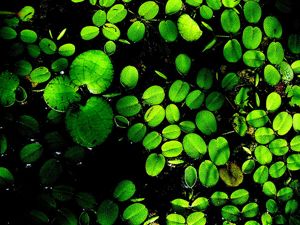Cool Fix: Algae from Wastewater
Air Date: Week of May 14, 2010

(Courtesy of Higetiger/Flickr)
Algae is a promising source of renewable fuel, but producers often use greenhouse gas-producing fertilizers to feed their aquatic crops. Living on Earth’s Bridget Macdonald reports on the potential for using wastewater as an alternative for growing algae.
Transcript
YOUNG: Just ahead—trying to clean up the polluted air at the Port of Los Angeles—but first, this cool fix for a hot planet from Bridget Macdonald.
[COOL FIX THEME]
MACDONALD: Wastewater treatment plants are designed to make sewage clean, but they could have an added benefit: growing algae for fuel.
[THEME]
MACDONALD: Using algae to make fuel is not a new idea—these photosynthetic organisms are efficient factories that convert sunlight to energy. Algae have fatty cells that are loaded with oil, so they can produce more energy than other biofuels crops on an acre-per-acre basis. But the tiny green plants have a relatively large carbon footprint when they’re cultivated on an industrial scale.
Commercial algae ponds are pumped with Co2 bubbles and nitrogen fertilizer—ingredients that stimulate algal growth, but also contribute to greenhouse gas emissions. Researchers at the University of Virginia say algae producers can make the process greener by using wastewater to grow their crops. Billions of gallons of sewage are processed in the U.S. every year, and many facilities use open lagoons in the treatment process. If algae producers set up shop next to these wastewater ponds, they could tap into readily available organic nutrients. It’s a win-win situation.

(Courtesy of Higetiger/Flickr)
Nitrogen and phosphorus must be removed from wastewater before it can be released into the environment - a process that is costly. The algae provide a public service by absorbing these unwanted elements from the water. Pond scum has never sounded so sweet. That’s this week’s Cool Fix for a Hot Planet. I’m Bridget Macdonald.
[END THEME]
YOUNG: And if you have a Cool Fix for a Hot Planet, we'd like to know it. If we use your idea on the air, we'll send you a sleek electric blue Living on Earth tire gauge. Keeping your tires properly inflated can save hundreds of dollars in fuel. Call our listener line at 800-218-9988. Or email coolfix—that's one word—at loe dot org. Or post your idea on our new Facebook page – PRI’s Living on Earth.
Links
Living on Earth wants to hear from you!
Living on Earth
62 Calef Highway, Suite 212
Lee, NH 03861
Telephone: 617-287-4121
E-mail: comments@loe.org
Newsletter [Click here]
Donate to Living on Earth!
Living on Earth is an independent media program and relies entirely on contributions from listeners and institutions supporting public service. Please donate now to preserve an independent environmental voice.
NewsletterLiving on Earth offers a weekly delivery of the show's rundown to your mailbox. Sign up for our newsletter today!
 Sailors For The Sea: Be the change you want to sea.
Sailors For The Sea: Be the change you want to sea.
 The Grantham Foundation for the Protection of the Environment: Committed to protecting and improving the health of the global environment.
The Grantham Foundation for the Protection of the Environment: Committed to protecting and improving the health of the global environment.
 Contribute to Living on Earth and receive, as our gift to you, an archival print of one of Mark Seth Lender's extraordinary wildlife photographs. Follow the link to see Mark's current collection of photographs.
Contribute to Living on Earth and receive, as our gift to you, an archival print of one of Mark Seth Lender's extraordinary wildlife photographs. Follow the link to see Mark's current collection of photographs.
 Buy a signed copy of Mark Seth Lender's book Smeagull the Seagull & support Living on Earth
Buy a signed copy of Mark Seth Lender's book Smeagull the Seagull & support Living on Earth

